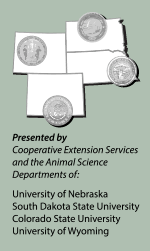De-Commoditizing the Feeder Calf Market
Details are important, and programs that provide information to prospective buyers can earn premiums.
LOVELAND, Colo. (Nov. 19, 2015) — How can you move beyond being an average producer? How can cattle producers “de-commoditize” the cattle market and capture premiums? Those where questions cattlemen Lee Leachman and Tom Brink challenged Range Beef Cow Symposium attendees to think about during the final day of the event Nov. 19 in Loveland, Colo. Leachman operates Leachman Cattle of Colorado, and Brink operates his own business, Top Dollar Angus.
“Information matters; that’s how we de-commiditize cattle,” said Brink. He noted that information can help show that a group of cattle is different in a positive way.
Specifically he shared that prospective buyers are interested in frame size and flesh condition; health programs, especially for calves; and genetics.
Regarding health programs, Brink emphasized that details — from treatment protocols to administration dates — are important. “Don’t overlook the value of rolling health information into marketing,” Brink stated.
In discussing genetics, Brink shared a comparison of the top 10 performing steers in a pen to the bottom 10 performing cattle in the same pen, and said, “There’s a horrendous value difference in cattle.” In this particular pen, the value difference per head spanned $457.
Brink noted that by gathering performance information, producers and buyers have the ability to identify premium cattle.
He called DNA testing “a good and useful tool,” and said, “DNA is coming and coming fast. … We’re going to see more of it.”
Brink’s business, Top Dollar Angus, works with producers to garner premiums for high-performing cattle. Similarly, Leachman talked about the Reputation Feeder Cattle program, which takes genetics and management data to run a simulation model to predict the expected outcome on a group of cattle. Reputation Feeder Cattle also offers certification on cattle enrolled in the program and assists in promotion of those cattle to buyers.
Leachman concluded, “The premise goes back to that question “How can you manage what you don’t know? Producers can use [DNA] information to get top dollar or use the information to improve future cattle performance if you don’t have great results.”
Editor’s Note: Tom Brink accepted the position as CEO of the Red Angus Association of America and will begin that role in mid-January. For more, click here. This summary was written under contract or by staff of the Angus Journal®, which retains the copyright. To request to reprint this article, contact Shauna Rose Hermel, editor, at 816-383-5270. PowerPoints are posted with permission of the presenter and may not be reproduced in whole or in part without the express permission of the presenter. Angus Journal claims copyright to this web site as presented. We welcome educational venues and cattlemen to link to this site as a service to their audience.
The Angus Journal's coverage of the event is made possible through collaboration with the event committee and sponsorship of LiveAuctions.tv. For questions about this site, or to notify us of broken links, click here. Look for additional coverage in the Angus Journal, the Angus Beef Bulletin, the Angus Journal Daily, the Angus Beef Bulletin EXTRA and Angus TV.


